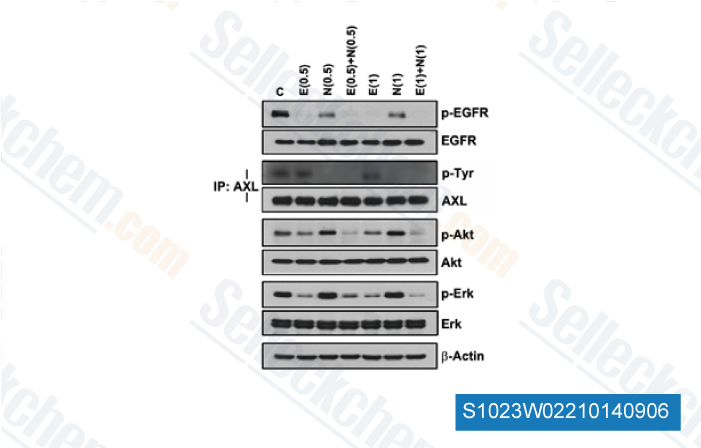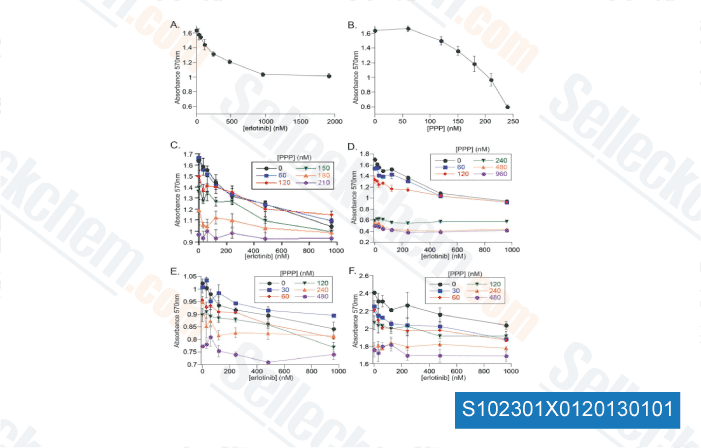|
Toll Free: (877) 796-6397 -- USA and Canada only -- |
Fax: +1-832-582-8590 Orders: +1-832-582-8158 |
Tech Support: +1-832-582-8158 Ext:3 Please provide your Order Number in the email. |
Technical Data
| Formula | C22H23N3O4.HCl |
||||||
| Molecular Weight | 429.90 | CAS No. | 183319-69-9 | ||||
| Solubility (25°C)* | In vitro | DMSO | 6 mg/mL (13.95 mM) | ||||
| Water | Insoluble | ||||||
| Ethanol | Insoluble | ||||||
| In vivo (Add solvents to the product individually and in order) |
|
||||||
|
* <1 mg/ml means slightly soluble or insoluble. * Please note that Selleck tests the solubility of all compounds in-house, and the actual solubility may differ slightly from published values. This is normal and is due to slight batch-to-batch variations. * Room temperature shipping (Stability testing shows this product can be shipped without any cooling measures.) |
|||||||
Preparing Stock Solutions
Biological Activity
| Description | Erlotinib HCl is an EGFR inhibitor with IC50 of 2 nM in cell-free assays, >1000-fold more sensitive for EGFR than human c-Src or v-Abl. | ||
|---|---|---|---|
| Targets |
|
||
| In vitro | Erlotinib HCl potently inhibits EGFR activation in intact cells including HNS human head and neck tumor cells (IC50 20nM), DiFi humancolon cancer cells andMDA MB-468 human breast cancer cells. Erlotinib HCl (1 μM) induces apoptosis in DiFi humancolon cancer cells. [1] Erlotinib inhibits growth of a panel of NSCLC cell lines including A549, H322, H3255, H358 H661, H1650, H1975, H1299, H596 with IC50 ranging from 29 nM to >20 μM. [2] Erlotinib HCl(2 μM) significantly inhibits growth of AsPC-1 and BxPC-3 pancreatic cells. [3] The effects of Erlotinib HCl in combination with gemcitabine are considered additive in KRAS-mutated pancreatic cancer cells. Ten micromolar of Erlotinib HCl inhibits EGFR phospho-rylation at the Y845 (Src-dependent phosphorylation) and Y1068 (auto-phosphorylation) sites. [4] Combination with Erlotinib HCl could down-modulate rapamycin-stimulated Akt activity and produces a synergistic effect on cell growth inhibition. [5] | ||
| In vivo | At doses of 100 mg/kg, Erlotinib HCl completely prevents EGF-induced autophosphorylation of EGFR in human HN5 tumors growing as xenografts in athymic mice and of the hepatic EGFR of the treated mice. [1] Erlotinib HCl (100 mg/Kg) inhibits H460a and A549 tumor models with 71 and 93% inhibition rate. [5] |
Protocol (from reference)
| Kinase Assay:[1] |
|
|---|---|
| Cell Assay:[2] |
|
| Animal Study:[6] |
|
References
Customer Product Validation

-
Data from [Cancer Res, 2014, 4(1):253-62]

-
Data from [Tuberc Respir Dis, 2013, 75(1), 9-17]

-
Data from [Head Neck, 2013, 35, 86-93]

-
Data from [Nat Genet, 2012, 44(8):852-60]
Selleck's Erlotinib HCl has been cited by 614 publications
| Reciprocal regulation of MMP-28 and EGFR is required for sustaining proliferative signaling in PDAC [ J Exp Clin Cancer Res, 2025, 44(1):68] | PubMed: 39994761 |
| Integration of 3D bioprinting and multi-algorithm machine learning identified glioma susceptibilities and microenvironment characteristics [ Cell Discov, 2024, 10(1):39] | PubMed: 38594259 |
| RAB22A sorts epithelial growth factor receptor (EGFR) from early endosomes to recycling endosomes for microvesicles release [ J Extracell Vesicles, 2024, 13(7):e12494] | PubMed: 39051763 |
| Metabolic imaging distinguishes ovarian cancer subtypes and detects their early and variable responses to treatment [ Oncogene, 2024, 10.1038/s41388-024-03231-w] | PubMed: 39639170 |
| Hepatocellular RECK as a Critical Regulator of Metabolic Dysfunction-Associated Steatohepatitis Development [ Cell Mol Gastroenterol Hepatol, 2024, S2352-345X(24)00119-X] | PubMed: 38797477 |
| Establishment, characterization, and biobanking of 36 pancreatic cancer organoids: prediction of metastasis in resectable pancreatic cancer [ Cell Oncol (Dordr), 2024, 10.1007/s13402-024-00939-5] | PubMed: 38619751 |
| The deubiquitinase USP9X regulates RIT1 protein abundance and oncogenic phenotypes [ iScience, 2024, 27(8):110499] | PubMed: 39161959 |
| Lysine Methyltransferase 9 (KMT9) Is an Actionable Target in Muscle-Invasive Bladder Cancer [ Cancers (Basel), 2024, 16(8)1532] | PubMed: 38672614 |
| Transcriptomic Analysis Reveals Early Alterations Associated with Intrinsic Resistance to Targeted Therapy in Lung Adenocarcinoma Cell Lines [ Cancers (Basel), 2024, 16(13)2490] | PubMed: 39001552 |
| Establishment and molecular characterization of HCB-541, a novel and aggressive human cutaneous squamous cell carcinoma cell line [ Hum Cell, 2024, 10.1007/s13577-024-01054-1] | PubMed: 38565739 |
RETURN POLICY
Selleck Chemical’s Unconditional Return Policy ensures a smooth online shopping experience for our customers. If you are in any way unsatisfied with your purchase, you may return any item(s) within 7 days of receiving it. In the event of product quality issues, either protocol related or product related problems, you may return any item(s) within 365 days from the original purchase date. Please follow the instructions below when returning products.
SHIPPING AND STORAGE
Selleck products are transported at room temperature. If you receive the product at room temperature, please rest assured, the Selleck Quality Inspection Department has conducted experiments to verify that the normal temperature placement of one month will not affect the biological activity of powder products. After collecting, please store the product according to the requirements described in the datasheet. Most Selleck products are stable under the recommended conditions.
NOT FOR HUMAN, VETERINARY DIAGNOSTIC OR THERAPEUTIC USE.
